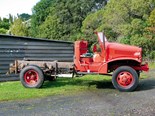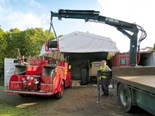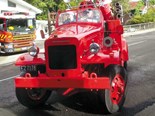1942 International fire truck restoration: part 4




 The 500 gallon-per-minute pump prior to being removed.
The 500 gallon-per-minute pump prior to being removed.


|

|

|
|
The 500 gallon-per-minute pump prior to being removed.
|
The fourth chapter in Lyndsay Whittle’s epic 1942 International fire truck restoration project.
When I was screaming down Piha Road 40-odd years ago, sometimes standing on the back, sometimes as the driver, I’d have never dreamed that one day in 2015 I’d be restoring the old machine.
After spending the better part of the past three months dismantling the old truck, we were looking forward to starting the process of putting it all back together again.
In a strict sense, I suppose the reassembling process had already begun a couple of weeks earlier, as we had previously cut the rusted rear portion of the cab out, prepped and painted everything before the 400-gallon water tank could be put back in place.
Murray and I had even taken the rear panel to the Auckland Car Club’s Penrose workshop and put a swage in it to match the swaged corner panels.
This was our first crack at using a swage machine and, while it’s fair to say we didn’t do too badly for a first attempt, it possibly wouldn’t have quite passed muster if it was to have been in full public view.
However, the purpose the swage in this instance was to provide strength to the panel, not necessarily to be aesthetically pleasing, so once the finished product had been viewed and approved by the vehicle’s custodians, we were free to continue with the reconstruction job.
The water jetting process I spoke of in the previous issue had done a spectacular job on the chassis, so giving it a good protective coat of paint was a breeze, although there was still the issue of convincing the chief and deputy of Titirangi Fire Brigade that black was the colour it should be, not red.
Anyway we needed to crack on if we were going to have the truck back on the road in time for the old truck’s appointment with its annual round of Christmas parades, so the powers agreed that it would be black.
While 80 percent of the work was carried out in-house, there were a few jobs that were best left to people who had the required equipment we didn’t have at hand.
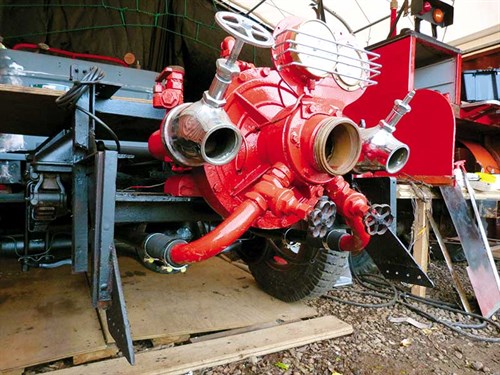
One such job was upholstering the bench seat that had endured many years of being at the mercy of the elements given the open-top configuration of the truck.
I can recall a time, many years ago, when the International (RT call-sign Waiatarua 124) was situated at Waiatarua Station in the Waitakere Ranges, and we got a call to a barn on fire up near Hobsonville Airbase, at least 20 kilometres away.
The reason our appliance was on the turnout was because of our truck’s water-carrying capacity of 400 gallons – this was at a time when many city trucks only carried a nominal amount of water.
AT the time, I was young and keen and most probably pushed in front of a more capable driver to drive under lights and siren for this unusually long-duration fire call.
All was going well for me until fate stepped in when the heavens opened up and dumped a flood of biblical proportion upon the scene.
Strangely, when the time came to make the long journey home, I found that the rest of the crew had scrounged a ride home in covered vehicles, leaving me to make the long and lonely trip back home by myself, soaking wet.
These days of course, while driving slowly in Christmas parades and the like, the covering has to endure many hours sitting in the hot summer sun as well.
Anyway, the guys at Waikumete Car Upholsterers made sure they covered this one with a material that will see the truck through many parades to come.
Rather than spending countless hours applying copious amounts of elbow grease to all the brass that’s associated with firefighting equipment of this era, we decided to call upon an old friend John Terei of Terei Brothers Plating and Polishing to take care of this part of the operation.
While John took care of dismantling, polishing and reassembling the dozens of components that make up what is termed as ‘waterway equipment’ in firefighting parlance, the rest of his team looked after the chrome plating side of things.
Meanwhile back at home base, the rest of our team busied themselves with preparing the water tank to go back on the chassis and also work done on the locker module while it was sitting on the back of the little FGK 30 Morris, which has been the International’s bedfellow during the course of the restoration.
For the benefit of those who missed out on reading last month’s instalment, I should explain that one of the concerns we originally had was that the wooden frame of the locker module would be rotten, as borer dust exuded into the atmosphere whenever a locker door was opened.
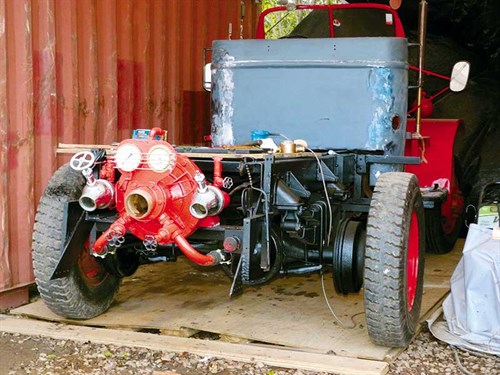
It turned out that this was due to the upper part of the hinged locker doors being made of inferior timber, which in the final event turned out to be a much easier fix than replacing the framing material – not without its problems, but a much easier job nonetheless.
One of the jobs that took us a quite a bit longer than we anticipated was the replacement of the rubber matting that sits atop the module.
Sometime in the more-recent past, much of the rubber on the back of the truck had been replaced, but obviously the part that had been worn thin by countless years of being massaged by firemen’s backsides had been put in the too-hard basket at replacement time.
It’s easy to see why someone just couldn’t be bothered, as the whole shebang was attached with what seemed like a million screws, many of which had rusted into the wooden frame, making them buggers of things to get out.
I know we could have drilled them out but then we’d have had to have used modern screws to reattach the new rubber.
Try as we may, we couldn’t find anyone who supplies dome-headed countersink slotted screws. If anyone knows where these can be obtained, we’d love to hear from you.
At the time of putting this story together we only have a couple of weeks remaining to get this show on the road, so a lot has to happen in the next few days.
The restoration team is down to two of us at the moment, just Murray and me, as Dean is currently away on leave. In fact the team of two will remain the status quo for the remainder of the restoration.
Since the last instalment we’ve called in ex-Titirangi fire chief Gordon Latham with his Hiab to put the module back and to place the water tank snugly between the module and the cab, which proved a little tricky due to the tight fit – however we made it without incident.
We’ve put the pump back in and new suction hose has been fitted to the original brass fittings by PSL Fire and Safety and is soon to be placed on the truck.
Given that we’ve only got two weeks to go until the old truck makes its first appearance at the 2015 round of parades I’d better get cracking.
For the latest news and reviews, subscribe to Deals On Wheels magazine here.
Keep up to date in the industry by signing up to Deals on Wheels' free newsletter or liking us on Facebook.


.jpg)



.jpg)


.jpg)


